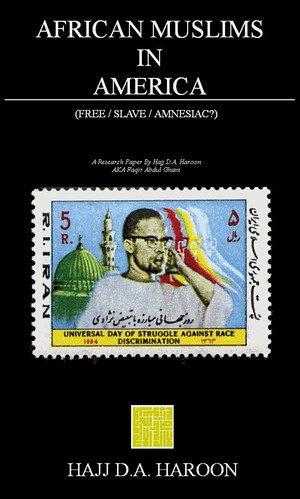Friday, July 28, 2006
Race and Religion - An Interview with a Blackamerican Muslim
I was invited to be a part of a spiritual biography project earlier this year. An excerpt of that interview is now available for listening online. Check it out.
Thursday, July 27, 2006
Apostasy and How It Relates To American Muslims
I wrote a short piece on the new trend of Apostasy and how it may relate to our situation as indigenous, American Muslims. Read it here.
Tuesday, July 25, 2006
"i saw the bullet cry, i heard the man fall"
I've included a number of references to Louis Reyes Rivera (aka the Janitor of History) before on Planet Grenada, but this is probably the most "Grenada-esque" (An Afro-Latino writer giving a "contributive note" to a Black and Muslim and human hero). It is a beautiful spoken word piece by Rivera on the assassination of Malcolm X which he performed on Def Poetry Jam. I also have to admit that Def Jam is where I first heard of Rivera... which is a shame since he has been around for a while.
see also:
louis reyes rivera
inside the river of poetry
filiberto ojeda rios
see also:
louis reyes rivera
inside the river of poetry
filiberto ojeda rios
Tuesday, July 18, 2006
black/muslim split?
South Florida Sun-Sentinel: Dispute over mosque sheds light on black, Muslim split by Gregory Lewis is a follow-up on issue we've already referenced in: muslims and the black community
Monday, July 17, 2006
black israeli arabs
A little weird given current events, but still interesting
Hadassah Magazine: Black Israeli Arabs By Ruth Mason
Hadassah Magazine: Black Israeli Arabs By Ruth Mason
islamica magazine
salaams! the new issue of islamic magazine is featuring Africa throughout the mag. It has articles on w. african, e. african, somali mcs and poets, and it has an article on the enslaved prince ibrahima abdur-rahman. check out the mag if you can.
Wednesday, July 12, 2006
Friday, July 07, 2006
african muslims in america
I've been recently discussing the Sunni-Shia split on my blog, and in the midst of trying to learn more about the subject I came across Shaykh Fadhlalla Haeri, who apparently tries to bridge the gap between Sunni and Shia somehow. In any case... to make a long story short, I was looking at a website associated with him and found the online paper: African Muslims in America by Hajj D. A. Haroon (see here) and thought it would fit here at Third Resurrection. Enjoy.
Thursday, July 06, 2006
muslims and the black community
To follow-up on the story south florida black community objects to building new islamic center you might want also check out Tariq Nelson's entry Is black hostility to Muslims growing? and Umar Lee's Black Communities Views on Islam
Sunday, July 02, 2006
keith ellison and the nation
Keith Ellison, an African-American Muslim who is running for Minnesota's 5th Congressional district seat, wants voters to focus on the (U.S.) nation's future than the Nation (of Islam's) past.
the courts of somali opinion
It's hard for me to look at the U.S. response to the situation in Somalia and not think that this is a war on Islam. Why else would the US prefer the anarchy of the warlords to a unified Islamic regime (among a Muslim population)?
Alt.Muslim: The Courts of Somali Opinion
Alt.Muslim: The Courts of Somali Opinion
Subscribe to:
Posts (Atom)
